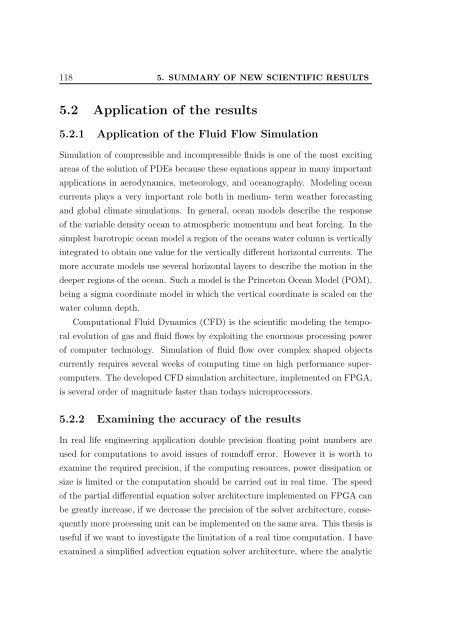PPKE ITK PhD and MPhil Thesis Classes
PPKE ITK PhD and MPhil Thesis Classes
PPKE ITK PhD and MPhil Thesis Classes
You also want an ePaper? Increase the reach of your titles
YUMPU automatically turns print PDFs into web optimized ePapers that Google loves.
118 5. SUMMARY OF NEW SCIENTIFIC RESULTS<br />
5.2 Application of the results<br />
5.2.1 Application of the Fluid Flow Simulation<br />
Simulation of compressible <strong>and</strong> incompressible fluids is one of the most exciting<br />
areas of the solution of PDEs because these equations appear in many important<br />
applications in aerodynamics, meteorology, <strong>and</strong> oceanography. Modeling ocean<br />
currents plays a very important role both in medium- term weather forecasting<br />
<strong>and</strong> global climate simulations. In general, ocean models describe the response<br />
of the variable density ocean to atmospheric momentum <strong>and</strong> heat forcing. In the<br />
simplest barotropic ocean model a region of the oceans water column is vertically<br />
integrated to obtain one value for the vertically different horizontal currents. The<br />
more accurate models use several horizontal layers to describe the motion in the<br />
deeper regions of the ocean. Such a model is the Princeton Ocean Model (POM),<br />
being a sigma coordinate model in which the vertical coordinate is scaled on the<br />
water column depth.<br />
Computational Fluid Dynamics (CFD) is the scientific modeling the temporal<br />
evolution of gas <strong>and</strong> fluid flows by exploiting the enormous processing power<br />
of computer technology. Simulation of fluid flow over complex shaped objects<br />
currently requires several weeks of computing time on high performance supercomputers.<br />
The developed CFD simulation architecture, implemented on FPGA,<br />
is several order of magnitude faster than todays microprocessors.<br />
5.2.2 Examining the accuracy of the results<br />
In real life engineering application double precision floating point numbers are<br />
used for computations to avoid issues of roundoff error. However it is worth to<br />
examine the required precision, if the computing resources, power dissipation or<br />
size is limited or the computation should be carried out in real time. The speed<br />
of the partial differential equation solver architecture implemented on FPGA can<br />
be greatly increase, if we decrease the precision of the solver architecture, consequently<br />
more processing unit can be implemented on the same area. This thesis is<br />
useful if we want to investigate the limitation of a real time computation. I have<br />
examined a simplified advection equation solver architecture, where the analytic






![optika tervezés [Kompatibilitási mód] - Ez itt...](https://img.yumpu.com/45881475/1/190x146/optika-tervezacs-kompatibilitasi-mad-ez-itt.jpg?quality=85)









